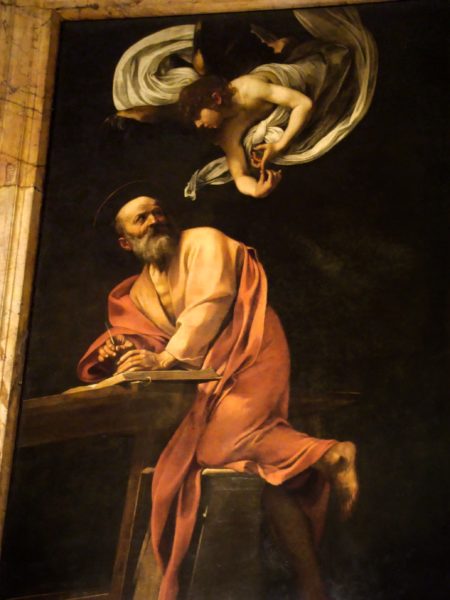
The Inspiration of Saint Matthew is a painting by the Italian Baroque master Michelangelo Merisi da Caravaggio. Commissioned by the French Cardinal Matteo Contarelli, the canvas hangs in Contarelli chapel altar in the church of the French congregation San Luigi dei Francesi in Rome, Italy.
Caravaggio~
Today a good friend is traveling to Italy to spend a month in Rome with his partner, who is there teaching architecture to American students for an American university architecture program. Sono molto geloso! Well, aren’t you jealous, too? Okay, maybe not jealous of teaching students, but definitely jealous of four weeks in the Eternal City. His journey there reminds me of a most wonderful story that his partner tells.
He tells of visiting a museum in Rome years ago and finding a painting by the 16th-17th Century Italian painter Michelangelo Merisi da Caravaggio. Caravaggio (pronounced “car-ah-VAHJ-joe”) is most known for his dramatic use of light and emotionally charged subject matter. I love this story so much that I have a feeling in about 10 years I will tell this story, shamelessly and without regard, as if it were my own. But until then, I will give appropriate credit by saying that this is my telling of his story.
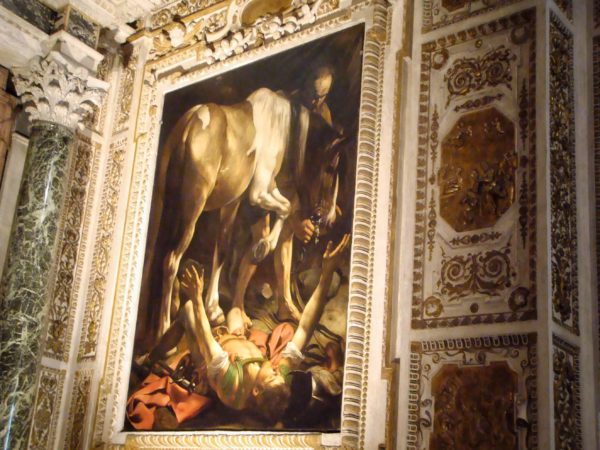
“The Conversion of Saint Paul,” by the Italian painter Caravaggio, painted in 1601 for the Cerasi Chapel of the church of Santa Maria del Popolo, in Rome.
On one of several architectural trips to Rome, my friends had given themselves the task of seeking out the paintings of Caravaggio that hang in churches, civic buildings, and museums throughout the city. On this particularly hot summer’s day they had spent the morning visiting churches and seeing Caravaggio’s The Conversion of Paul on the Road to Damascus, Crucifixion of Saint Peter, and Inspiration of Saint Matthew *, among others. After lunch they decided to wander into one of the museums that was listed as having a Caravaggio.
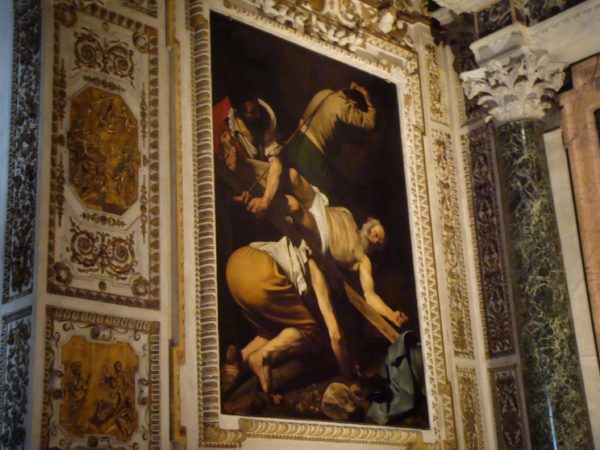
“The Crucifixion of Saint Peter” is a work by Michelangelo Merisi da Caravaggio, painted in 1601 for the Cerasi Chapel of Santa Maria del Popolo in Rome. Across the chapel is a second Caravaggio work depicting the Conversion of Saint Paul on the Road to Damascus.
When they approached the ticket booth, the elderly Italian woman behind the glass, smartly dressed in her blue guide’s uniform complete with a dark blue cardigan sweater over a oxford blue blouse, and fashionable eyeglasses on a chain hanging around her neck, informed them that the museum was closed because of a strike. In Italy, strikes are a daily occurrence and often they are location and event specific. Sometimes train workers will be on strike, but it will only affect certain routes at certain times of the day.
Here, this strike was affecting this particular museum only. Determined not to be turned away, they pleaded with the woman to be allowed in to visit the museum.
“No, mi dispiace,” was her reply.
“Per favore, we have spent the morning seeing Caravaggio paintings across the city and we’d like to see the one here.”
“No, mi dispiace.” She was not budging. The strike was on and the museum was closed.
My friends turned to leave and, a little too loudly, one said to the other “Well, I am sure it was not as good as the others we have seen.” And before they could step away, the formidable Italian woman, upon hearing his comment, let her pride get the better of her.
“Signori,” she said, stopping them with her voice, as she grabbed a large ring of keys and exited the booth, closing and locking the door behind her. “Andiamo!” (“Let’s go!”)
Waving them on to join her, this smartly dressed woman led my friends through the museum—up stairs, around corners, and down long hallways. She was a woman on a mission. There was no way she was going to be outdone by the other paintings that these Americans had seen.
She quickly waddled in her slightly tight, knee-length dark blue shirt down the dark and poorly lit hallways of this closed museum. The 2-inch heels of her fashionable, yet practical, shoes echoed their “click, click, click” as she made her way toward her destination, even as her two Americans stumbled along trying to keep her pace, straining to get a glimpse of the other masterpieces that hung in this strike-forsaken, stuffy, and stale-aired building.
At the end of a hallway she took an abrupt right and turned into an even darker room. My friends were sweating now and slightly out of breathe, when their cool and collected guide stopped them in the middle of the room. “Aspettate qua!” (“Wait here!”)
They stood panting and squinted to see what was in this room as the woman made her way over to two large, heavily curtained windows. She reached up, grabbed one of the thick, velvet drapery panels and with a quick and mighty jerk of her arm, this short, elderly Italian woman threw open the drapery letting a shaft of bright sunlight cut through the dusty and darkened room to illuminate the painting now before my friends.
The quick, loud sound of the metal drapery rings slamming against each other, the shaft of blinding light streaming across the room and striking the graphic image of the painting made my friends grab each other’s arm and gasp in surprise at what they saw.
A moment of silence—as the dust danced in the shaft of sunlight, the woman standing with pride at the window, and my friends, quietly awe-struck and slightly terrified, holding each other in front of the framed canvas.
“CAR-A-VAG-GIO!” the woman exclaimed, breaking the silence. She stressed his name with such confidence, with such pride, proving that there was no more important painting by the Italian master than this one. The only thing that was missing was an organ chord “sting” as she opened the drape, followed by three descending notes, “duh-duh-duh,” after she said his name.
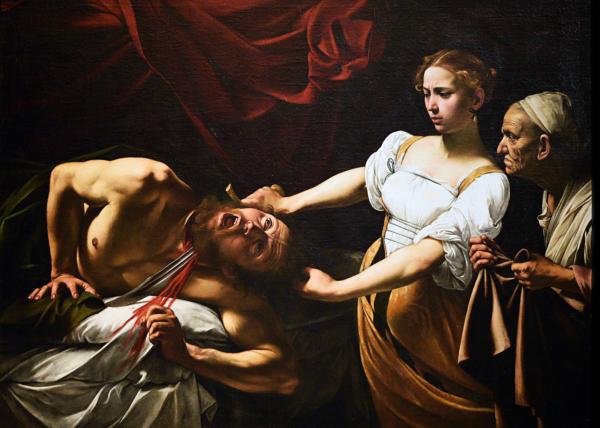
“Judith Beheading Holofernes” is a painting of the biblical episode by Caravaggio, painted in c. 1598–1599 or 1602, in which the widow Judith stayed with the Assyrian general Holofernes in his tent after a banquet then decapitated him after he passed out drunk. It is located in the Palazzo Barberini, Rome.
And as quickly as she had thrown the drape open, she yanked it closed, cutting off the light as they looked upon the image of Judith Beheading Holofernes. The guide clicked her way out of the room, rushing them just as quickly out as she had in.
If you go to Italy, you will see these women scattered throughout the museums in Rome. Well manicured, put together, stylishly uniformed, and prideful museum guides and staff whose job it is to keep you from getting too close to the art.
But on this day, my friends had a guided trip to meet the master up close and personal—and at his best.
“CAR-A-VAG-GIO!”
“Duh”
“Duh”
“Duhhhhhhhhhh”
Buona giornata,
Mark
Author of “Beyond the Pasta; Recipes, Language & Life with an Italian Family.”
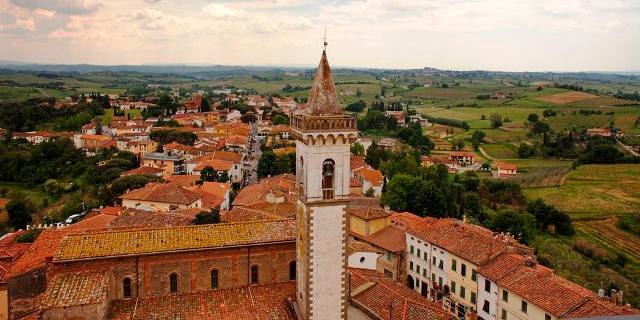







Looks like the old bait & switch at the barber shop for Holofernes! Wonderful story, as always!